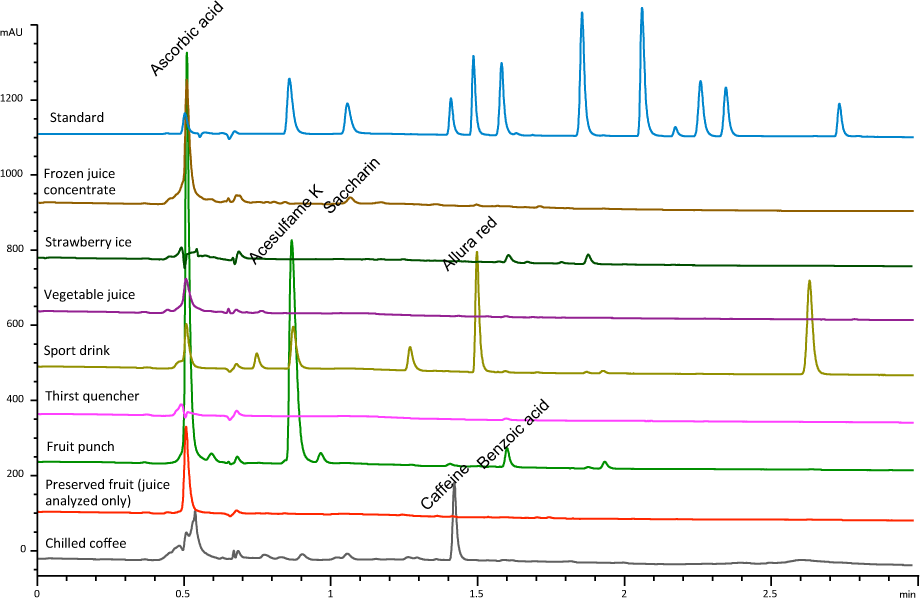Access Agilent eNewsletter, January 2014
>> Update My Profile | Subscribe to Access Agilent | Article Directory

Choosing the right filter for food and drink analysis made easy by Agilent
By Limian Zhao
Agilent Sample Prep
Non-nutritive food additives are frequently used in beverage and food products, such as preservatives, sweeteners, colorants, and stimulants. These additives are generally safe, but at certain levels can be harmful, such as causing an allergic reaction or hyperactivity in children. Use of non-nutritive additives is restricted in some countries, so the analysis of these compounds in food quality control is important in ensuring compliance with international regulations.
Remove troublesome particles
Many synthetic or artificial additives are water soluble, making them perfect for analysis by HPLC with reversed-phase columns. Most beverages are LC-compatible and have a less complicated sample matrix, making them suitable for direct injection or dilution followed by injection onto the LC column. The biggest concern is the negative impact on the column caused by particulates in food samples. Filtration, therefore, is usually recommended as the major sample preparation procedure, especially for samples with high particulate levels, such as fruit juice. Some drinkable products, such as yogurt and iced coffee, have milk added. These milk proteins can be removed via simple precipitation by organic solvents, followed by centrifugation or filtration.
In our study, a variety of Agilent Captiva Premium Syringe Filters were tested to identify the most appropriate filter type for rigorous, effective sample preparation of food and beverages. The selected filter was then used in an analysis of additives in several challenging food and drink samples.
The right filter for the right result
Based on the sample medium, different syringe filters were evaluated for filtration recovery. Figure 1 shows the results of this test in an aqueous-organic dietary drink. In Figure 2 we show the results of the test with an aqueous sport drink.
 Enlarge
Enlarge
Figure 1. Filtration recovery evaluation for aqueous organic mixed sample.
 Enlarge
Enlarge
Figure 2. Assessing filtration recovery of additives in a sport drink using Agilent Captiva premium syringe filters. Samples were directly filtered prior to HPLC injection. RC, regenerated cellulose; PES, polyethersulfone; CA, cellulose acetate.
 Enlarge
Enlarge
Figure 3. Analysis of food additives in beverage products by HPLC/UV using filtration as the major sample preparation technique. Samples were filtered by Agilent Captiva Premium 0.45 µm Regenerated Cellulose syringe filters.
Regenerated cellulose (RC) filters provided excellent recovery for samples in both aqueous and aqueous/solvent mix sample media. As a result, RC 0.45 µm syringe filters were selected to prepare some market-available beverage/food product samples prior to HPLC analysis. These samples were either directly used or appropriately diluted with water or organic solvent due to the abundance of additives detected or the type of sample matrix. In addition to filtration, centrifugation for two minutes at 13,000 rpm was used for comparison. Compound identification was based on retention time and UV spectrum comparison of the beverage/food samples with standards. Relative recovery (%) was the peak area ratio of additive in the filtered sample compared to the centrifuged sample. These results are shown above in Figure 3 and below in Table 1.
Beverage/food sample |
Sample preparation |
Additives found |
Mean relative recovery (%) (n = 3)* |
|---|---|---|---|
Frozen juice concentrate |
Thaw at room temperature, 10x dilution with water |
Ascorbic acid |
103.4 |
Saccharine |
103.1 |
||
Strawberry ice |
Thaw at room temperature, 2x dilution with MeOH, vortex |
N/A |
N/A |
Vegetable juice |
10x dilution with water, vortex |
Ascorbic acid |
99.4 |
Sport drink |
Direct use |
Ascorbic acid |
97.0 |
Acesulfame K |
99.3 |
||
Allura red |
94.6 |
||
Thirst quencher |
Direct use |
N/A |
N/A |
Fruit punch |
Direct use |
Ascorbic acid |
100.8 |
Acesulfame K |
100.2 |
||
Benzoic Acid |
100.2 |
||
Preserved fruit (only juice analyzed) |
10x dilution with water, vortex |
Ascorbic acid |
98.6 |
Chilled coffee |
3x dilution with acetonitrile, vortex |
Caffeine |
101.6 |
Relative recovery = peak area of compound in filtered sample x 100% peak area of compound in centrifuged sample
Table 1. Food and beverage sample preparation and additive recoveries.
Easy and effective filtration
Agilent Captiva Premium Syringe Filters enable easy, simple, efficient, and robust sample preparation for the analysis of food additives in beverage/drinkable food products. Beverage and drinkable food products can be either directly filtered or diluted following filtration prior to HPLC analysis. For products that contain large amount of particulates, such as juice, depth filters can be used to prevent the filter membrane from getting clogged. Ultimately, the filters you choose should be based on the sample medium, the properties of the target analysis, and the needs of the instrumentation.
Agilent’s robust family of filtration solutions
Sample filtration before HPLC, UHPLC, LC/MS, GC, or GC/MS analysis is critical to achieving optimal system performance and results. Agilent Captiva Premium Syringe Filters make the process faster than ever with the industry’s highest flow rates and loading capacities. In addition, Agilent sets the standard for LC/MS by testing and certifying more syringe filters to be completely free of observed extractables than any other manufacturer. All Agilent Captiva Premium Syringe Filters are supplied with an HPLC or LC/MS Certificate.
There are a variety of membrane types and pore sizes to choose from. Try our interactive selection tool or 3- Step selection guide to find the appropriate Agilent Captiva Premium Syringe Filter for your needs right now! Want even more details? Explore our Premium Syringe Filter Chemical Compatibility Chart and Step by step instructions for use.
>> Update My Profile | Subscribe to Access Agilent | Article Directory


